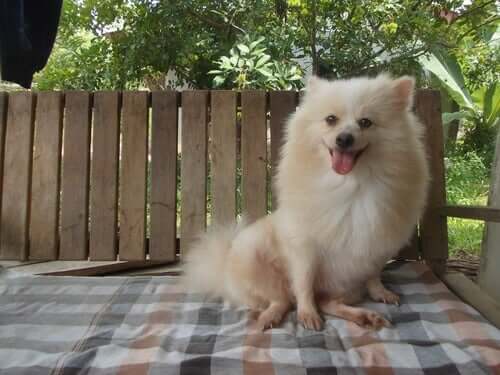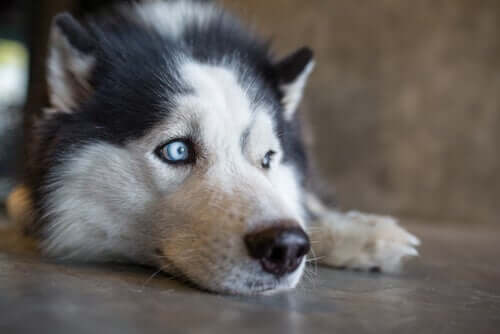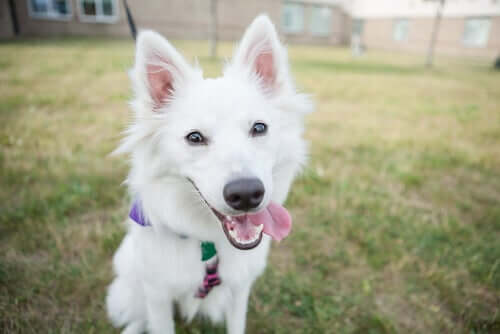All About Glaucoma in Dogs

Glaucoma is a disease that affects the eyes and causes progressive vision loss in dogs. Since it’s often asymptomatic, it’s necessary to pay attention to small changes in your dog’s behavior to be able to detect the condition. In this article, learn all about glaucoma in dogs.
Eyes are sophisticated and delicate structures that send external stimuli to the brain and interpret images. This is what we commonly call vision.
The visible part of the eye represents a small portion of the optical structure. This part is formed by the sclera (white part), iris (colored part), pupil (black dot), drainage channels, and ciliary tissues.
The non-visible part of the eye contains the cornea, lens, and retina, which is the lining of the eye. Also, it contains the optic nerve and the optic disk.
The joint action of all these elements enables the sense of sight. An alteration in any of these structures can lead to blindness and affect the nervous system.
Glaucoma in dogs is one of the most common ophthalmological conditions. Knowing how to recognize its early signs may save your best friend’s sight.
What’s glaucoma in dogs?
Glaucoma affects dogs a lot like how it affects humans. This condition consists of the accumulation of liquid that leads to a progressive increase in intraocular pressure.

The anterior part of the eye rests in a transparent liquid called aqueous humor or intraocular fluid. It’s produced by the ciliary epithelium and its function is to provide protective hydration. If this area dries out, it could cause various injuries or irritations.
A healthy eye has a dynamic movement. The fluid comes out of the intraocular cavity and into the pupil. The trabecular meshwork that composes the ocular drainage system should absorb this fluid almost immediately. Then, it reaches the bloodstream.
Eventually, the drainage passages become clogged and hinder the flow of aqueous humor. An excess of liquid inside the eye generates a progressive increase in intraocular pressure. When this process affects the eyes of dogs, it’s called glaucoma in dogs or canine glaucoma.
Increased intraocular pressure accelerates degeneration of the optic nerve and retina. The most common consequence of this condition is partial vision loss or blindness.
The causes of glaucoma
Glaucoma in dogs can be chronic or acute. Generally, it has a strong hereditary factor. Therefore, the main cause of this disorder is genetic inheritance.
It should be noted that glaucoma can also result from other diseases that affect the animal.
All about the symptoms of glaucoma in dogs
In most cases, dog owners become aware of the disorder only when the animal has already lost part of its vision. Basically, when the animal’s eye looks cloudy and slightly bluish.
However, the blindness caused by glaucoma results from gradual vision loss. Logically, it’s hard for a dog to indicate that it’s losing its vision.
Early symptoms of glaucoma in dogs
- Pain or tenderness in the eyes and/or head
- Nausea and/or vomiting
- Bluish and/or cloudy appearance of the corneas (especially when exposed to light)
- Difficulty with spatiotemporal location

Glaucoma in dogs is usually a silent disease. When dogs have vision problems, they may begin to walk with difficulty, knocking down or hitting objects. They do this because they can’t see well and can’t avoid the obstacles in their way.
Treatment of glaucoma in dogs
Treatment of glaucoma in dogs is pretty similar to that of humans and depends on the degree of evolution of the disorder. However, it’s very important for the dog’s veterinarian to prescribe a suitable treatment for it.
Generally, they prescribe eye drops to balance the drainage system and control intraocular fluid. Also, veterinarians commonly prescribe painkillers and/or anti-inflammatory drugs to relieve strong headaches and eye pain.
In more advanced cases, surgical procedures are recommended. These procedures use laser technology to artificially drain the intraocular cavity.
Although there’s no specific method to prevent glaucoma in dogs, responsible pet ownership is the best way to preserve the health of your best friend. Vaccinating and deworming your dog when needed, providing them a balanced diet, and allowing them to exercise can save their life.
